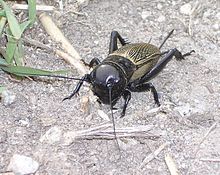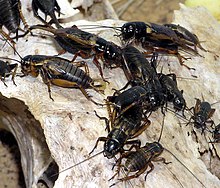| Gryllus | |
|---|---|

| |
| Female Gryllus campestris | |

| |
| Gryllus bimaculatus | |
| Scientific classification | |
| Domain: | Eukaryota |
| Kingdom: | Animalia |
| Phylum: | Arthropoda |
| Class: | Insecta |
| Order: | Orthoptera |
| Suborder: | Ensifera |
| Family: | Gryllidae |
| Tribe: | Gryllini |
| Genus: | Gryllus Linnaeus, 1758 [1] |
| Species | |
|
Many, see text | |
Gryllus is a genus of field cricket (Orthoptera, Gryllidae, Gryllinae). Members of the genus are typically 15–31 mm long and darkly coloured.[2] The type species is Gryllus campestris L.: the European field cricket.
History
[edit]Until the mid-1950s, native field crickets in eastern North America were all assigned to a single species, Acheta assimilis. Although regional variation in calling song and life history were noted,[3][4] no morphological characters could be found to reliably distinguish these variants.[5] Building upon the pioneering work of Fulton,[4] Alexander [5] used male calling song, life history and crosses between putative species to revise the taxonomy of gryllines in the eastern United States, and recognized five species, although at the time they were still classified in the genus Acheta.
Description
[edit]Species in this genus often look similar to species from other genera. They can often only be distinguished by the male genitalia. The epithallus typically consists of three lobes, the middle one being longer and more slender than the rest, in American and European species. African species, however, show more variability, making it more difficult to assign species to a genus with the same degree of certainty as there is more overlap with closely related genera.[6]
Distribution
[edit]Gryllus is one of the most widespread cricket genera. It is found in Africa, North and South America, Europe and Asia.[6]
Species
[edit]The genus contains the following species as of March 2023:[7][8]
- Gryllus abditus Otte & Peck, 1997
- Gryllus abingdoni Otte & Peck, 1997
- Gryllus abnormis Chopard, 1970
- Gryllus alogus Rehn, 1902 – damp-loving field cricket
- Gryllus amarensis (Chopard, 1921)
- Gryllus ambulator Saussure, 1877
- Gryllus argenteus (Chopard, 1954)
- Gryllus argentinus Saussure, 1874
- Gryllus armatus Scudder, 1902
- Gryllus assimilis (Fabricius, 1775) – Jamaican field cricket
- Gryllus ater Walker, 1869
- Gryllus barretti Rehn, 1901
- Gryllus bellicosus Otte & Cade, 1984
- Gryllus bicolor Saussure, 1874
- Gryllus bimaculatus De Geer, 1773
- Gryllus braueri (Karny, 1910)
- Gryllus brevecaudatus (Chopard, 1961) – short-tailed field cricket
- Gryllus brevicaudus Weissman, Rentz, Alexander & Loher, 1980
- Gryllus bryanti Morse, 1905
- Gryllus campestris Linnaeus, 1758
- Gryllus capitatus Saussure, 1874
- Gryllus carvalhoi (Chopard, 1961)
- Gryllus cayensis Walker, 2001 – Keys wood cricket
- Gryllus chaldeus (Uvarov, 1922)
- Gryllus chappuisi (Chopard, 1938)
- Gryllus chichimecus Saussure, 1897
- Gryllus cohni Weissman, Rentz, Alexander & Loher 1980
- Gryllus comptus Walker, 1869
- Gryllus conradti (Bolivar, 1910)
- Gryllus darwini Otte & Peck, 1997
- Gryllus debilis Walker, 1871
- Gryllus firmus Scudder, 1902 – sand field cricket
- Gryllus fultoni (Alexander, 1957) – southern wood cricket
- Gryllus fulvipennis Blanchard, 1854
- Gryllus galapageius Scudder, 1893
- Gryllus genovesa Otte & Peck, 1997
- Gryllus insularis Scudder, 1876
- Gryllus integer Scudder, 1901 – western trilling cricket
- Gryllus isabella Otte & Peck, 1997
- Gryllus jallae Giglio-Tos, 1907
- Gryllus kapushi Otte, 1987
- Gryllus krugeri Otte, Toms & Cade, 1988
- Gryllus lineaticeps Stål, 1861 – variable field cricket
- Gryllus luctuosus (Bolivar, 1910)
- Gryllus madagascarensis Walker, 1869
- Gryllus marchena Otte & Peck, 1997
- Gryllus maunus Otte, Toms & Cade, 1988
- Gryllus maximus (Uvarov, 1952)
- Gryllus meruensis Sjöstedt, 1909
- Gryllus miopteryx Saussure, 1877
- Gryllus multipulsator Weissman, 2009[9] – Long-chirp Field Cricket
- Gryllus mzimba Otte, 1987
- Gryllus namibius Otte & Cade, 1984
- Gryllus nigrohirsutus Alexander, 1991
- Gryllus nyasa Otte & Cade, 1984
- Gryllus opacus Chopard, 1927
- Gryllus ovisopis Walker, 1974 – taciturn wood cricket
- Gryllus parilis Walker, 1869
- Gryllus pennsylvanicus Burmeister, 1838 – fall field cricket
- Gryllus personatus Uhler, 1864 – Badlands cricket
- Gryllus peruviensis Saussure, 1874
- Gryllus pinta Otte & Peck, 1997
- Gryllus quadrimaculatus Saussure, 1877
- Gryllus rhinoceros Gorochov, 2001
- Gryllus rixator Otte & Cade, 1984
- Gryllus rubens Scudder, 1902 – eastern trilling cricket
- Gryllus scudderianus Saussure, 1874
- Gryllus signatus Walker, 1869
- Gryllus spinulosus Johannson, 1763
- Gryllus subpubescens (Chopard, 1934)
- Gryllus texensis Cade & Otte, 2000 – Texas trilling cricket
- Gryllus urfaensis Gumussuyu, 1978
- Gryllus veletis (Alexander & Bigelow, 1960) – spring field cricket
- Gryllus vernalis Blatchley, 1920 – northern wood cricket
- Gryllus vicarius Walker, 1869
- Gryllus vocalis Scudder, 1901 – vocal field cricket
- Gryllus zaisi Otte, Toms & Cade, 1988
- Gryllus zambezi (Saussure, 1877)
References
[edit]- ^ "Gryllus". Integrated Taxonomic Information System.
- ^ "Field crickets — Gryllus spp". Featured Creatures. University of Florida. Retrieved 2009-02-10.
- ^ Rehn, J.A.G., and Hebard, M. (1915). The genus Gryllus (Orthoptera) as found in America. Proc. Acad. Nat. Sci. Phila. 67:292-322.
- ^ a b Fulton, B. B. 1952. Speciation in the field cricket. Evolution 6, 283-295.
- ^ a b Alexander, R.D. (1957). The taxonomy of the field crickets of the eastern United States (Orthoptera: Gryllidae: Acheta). Ann. Entomol. Soc. Am. 50:584-602.
- ^ a b Otte, Daniel; Cade, William (1984). "African Crickets (Gryllidae). 6. The Genus Gryllus and Some Related Genera (Gryllinae, Gryllini)". Proceedings of the Academy of Natural Sciences of Philadelphia. 136: 98–122. ISSN 0097-3157.
- ^ "Gryllus". Global Biodiversity Information Facility. Retrieved 16 March 2023.
- ^ Species common names, BugGuide
- ^ Long-chirp field cricket, Singing Insects of North America (SINA)